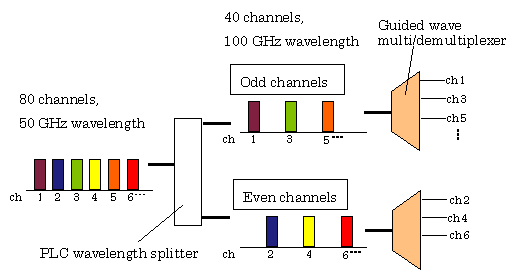2001 The former Hitachi Cable News Release
Information (including product prices, product specifications, details of services, launch dates, inquiry information, and URLs) contained in this news release is current as of the date of the press release but is subject to change without notice. Please note that details may differ from those effective on the search date.
Inaugurating Mass Production of PLC Wavelength Splitters*1
We are beginning mass production of PLC wavelength splitters for use in DWDM (Dense Wavelength Division Multiplexing*2) systems.
As you can see from the diagram below, a wavelength splitter is an optical component that doubles the intervals of transmitting wavelengths by breaking wavelengths into odd and even numbered channels or halves the intervals by merging them together.
High-speed and broadband optical transmission networks using cutting-edge transmission technology are continually being constructed in response to worldwide growth in Internet and multimedia services. WDM systems are being adopted because they can increase the number of wavelength channels to meet the rising demand for information transmission. This makes them a more economical choice than adding new fiber optic cables. Also, as the volume of information transmitted increases, WDM systems are becoming faster and able to handle more channels.
Therefore, we expect the market to grow for wavelength splitters. These components allow the addition of channels to existing WDM systems and make it possible to construct new systems to which channels can easily be added.
We can presently produce 100 PLC wavelength splitters per month at our Takasago Works (Hitachi city, Ibaraki prefecture). We are continually upgrading our manufacturing facilities to meet the rising demand and expect that a manufacturing system that can produce 300 units per month will be in place within the year. We forecast sales of 1.5 billion yen for fiscal 2002, and 2.5 billion yen for fiscal 2003. We aim to capture a large share of the global market for PLC wavelength splitters.
The wavelength splitters that we manufacture merge optical signals with a wavelength of 100 GHz into optical signals with a wavelength of 50 GHz, or break optical signals with a wavelength of 50 GHz into optical signals with a wavelength of 100 GHz. This makes it easy to add more channels to a WDM transmission system.
Our product has the following special features:
1) It uses low crosstalk optical circuit design and manufacturing technology to respond to the need for multiple channels.
2) Low dispersion to minimize the deterioration in optical pulse shape that occurs with high-speed signal transmission (such as 10 Gbps).
3) The component can be made smaller through adopting a Planar Lightwave Circuit that has high relative difference in refractive index*3. As a result, less energy (such as that from a heater) is consumed.
In addition to our work on the above PLC wavelength splitters, we are in the process of developing and bringing to production 1X4 guided-wave wavelength splitters which can break optical signals with a wavelength of 25 GHz into optical signals with a wavelength 100 GHz. We are also planning custom-made products.
| *1 | PLC wavelength splitters We introduced this product previously as an "interleaver," but from now on it will be called a "PLC wavelength splitters." |
| *2 | DWDM This is a type of communications technology that uses optical fibers. Wavelength Division Multiplexing (WDM) dramatically increases the volume of information that can be transmitted along a single optical cable by transmitting optical signals of different wavelengths simultaneously. The higher-density version of WDM is called Dense Wavelength Division Multiplexing (DWDM). |
| *3 | The relative difference in the refractive index is equal to the core rate of refraction minus the cladding rate of refraction, divided by the cladding rate of refraction Planar Lightwave Circuits form optical circuits from the difference in the refractive index between the core (through which the optical signal passes) and the cladding. The larger the difference in refractive index, the smaller the bend radius of the optical circuit. Therefore, even complex circuits can be created on a small surface. |
